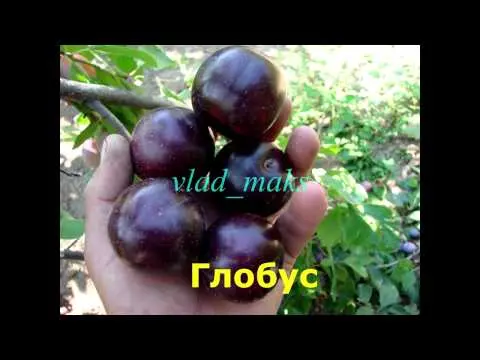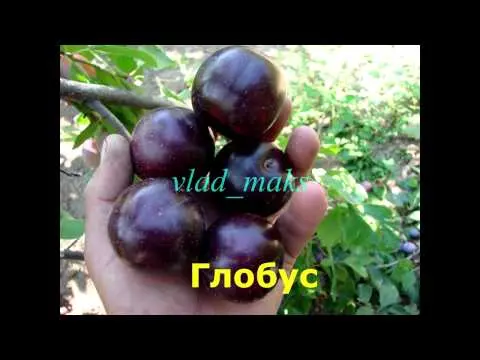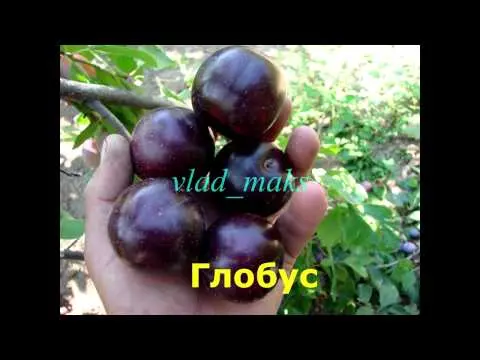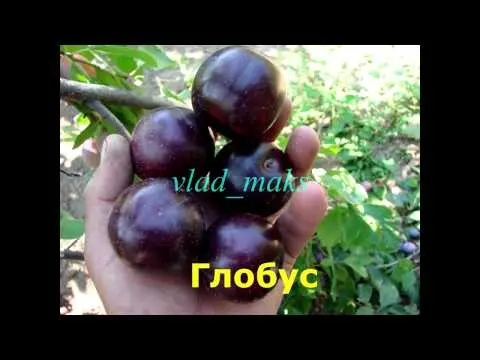Contents
Historically, cherry plum was considered a heat-loving crop that grows exclusively in the southern climate. However, its ability to easily cross with plum allowed breeders to obtain new winter-hardy varieties that can grow and bear fruit in the middle zone of the country, in particular in the Moscow region, as well as in regions with a more severe climate. Cherry plum varieties for the Moscow region combine the best characteristics of both fruit crops: they received high winter hardiness and large-fruitedness from plums, and excellent sour taste from cherry plums.
Varieties and varieties
In the mild southern climate, cherry plum trees are found everywhere in the wild. In the northern regions, as well as in the middle lane, this crop does not grow in natural conditions, because it does not have good winter hardiness. But on the other hand, it easily and quite successfully crosses with the plum that is familiar to us, which is more resistant to frost and sudden changes in temperature. Therefore, it was the plum that became the stock for breeding new varieties and hybrid forms of such a capricious and heat-loving cherry plum.
Today, cherry plum can be divided into several groups, which are a variety of cultivated wild cherry plum and growing in the southern climatic zone. For cold climatic conditions, in the last century, domestic breeders bred a hybrid form based on Chinese plum, from which new varieties with high winter hardiness were then obtained. Now these varieties of cherry plum are informally united under the common name ” plum”, since this is the plum, which is distinguished by a peculiar sour taste.
The most famous and frost-resistant varieties of hybrid cherry plum intended for cultivation in the middle lane are:
- Traveler. One of the most cold-resistant varieties of early (mid-July) ripening. The trees are compact with a rounded crown. Medium-sized fruits (25-30 g), bright yellow, with a reddish bloom, very fragrant. The pulp is fine-fibered, sweet and sour, the stone is separated poorly.
- Kuban comet. Variety of medium (beginning of August) ripening period. The trees are stunted, the crown is round, compact. The fruits are large, amber-yellow in color. The pulp is juicy, fine-fibered, soft, sweet-sour taste, does not separate from the stone. The yield of the variety is high, fruiting is abundant and regular, starting from the third year.
- Ruby. Very winter-hardy and drought-resistant variety of medium ripening. Yields are dependent on weather conditions and may therefore be unstable. Trees of medium height, crown lush, sprawling. The fruits are large (30-35 g), dark red or carmine color. The pulp is very juicy, the taste is sweet and sour.
- Timiryazevskaya. A hybrid obtained from the free pollination of the Kuban Comet cherry plum. Differs in high winter hardiness and early ripening. The fruits are orange with a reddish tinge. The pulp is quite sweet, with a mild honey taste, the stone is easily separated.
- Scythian gold. Another early variety, bred from the free pollination of the “Kuban Comet” in 2005. The trees are low (up to 2 m), sprawling. The fruits are light yellow in color, quite large (up to 40 g). The pulp is juicy and soft, moderately sweet taste.
- Cleopatra. Winter-hardy, high-yielding, but late variety. The fruits are large (37-40 g), outwardly they look like a plum: dark red, with a dark purple bloom. The pulp is red, fine-fibered, harmonious, moderately sweet taste. The stone is easily separated from the pulp.
- Early. Winter-hardy and early grade with large, as plum, reddish-orange fruits. The trees are stunted, fruiting is stable for 2-3 years. The pulp is yellow, juicy, quite sweet, with an easily separated stone.
- Mara. Winter-hardy and resistant to fungal diseases variety of Belarusian selection. Regular fruiting, average yield due to small fruits (20-23 g). The trees are compact, with a raised crown. The fruits are yellow, rounded, sweet and sour.
These are not all varieties suitable for growing in the middle lane. But you should also pay attention to such winter-hardy hybrids of domestic selection as Nesmeyana, Gift to St. Petersburg, red cherry plum Found, Red Ball, Yarilo – all these varieties are unpretentious and even in a cool climate are able to bring good yields.
Video “Varieties”
From the video you will learn a lot of new and interesting things about this fruit.
Planting a seedling
It is recommended to plant cherry plum seedlings in the middle lane in early spring, as soon as the snow melts. It is necessary to have time to plant before the buds swell, since a plant that has already begun to grow takes longer and more difficult. Plants with closed roots can be planted later, but care should be taken that the seedling is removed from the pot along with a clod of earth. It is not advisable to plant cherry plum in the fall, since it will not have time to take root before the onset of cold weather, and the low winter hardiness of the culture is unlikely to allow a fragile tree to survive severe winter frosts.
A place for planting cherry plum should be chosen open, illuminated by the sun for more than half a day, but protected from the northern winds.
The culture is not very demanding on the soil, but well-drained and rich in organic matter will contribute to good growth and abundant fruiting of the tree. The acidity of the soil for cherry plum should be neutral or slightly shifted in one direction or another – it is impossible to plant trees in acidic or too alkaline soil.
The process of planting seedlings consists of the following steps:
- A planting hole is dug 50×50 in size and 40-60 cm deep (depending on the size of the root system).
- The top layer of the earth is mixed with fertilizers (compost or humus 0,5 buckets, a handful of ash and 300 g of double superphosphate).
- The fertile mixture is poured back into the pit.
- Directly in the mind, a stake or a strong stick is set up to tie up the seedling.
- The seedling is placed vertically in the pit, the roots straighten out.
- Further, the tree is manually covered with earth, each layer of which is compacted so that voids do not form.
- After planting, the seedling is watered under the root with 1 bucket of water.
- Gently tie the tree to the stake with twine.
- If desired, the trunk circle can be covered with a thin layer of peat or compost mulch.

If several trees are planted on the same site at the same time, then the distance between them must be calculated based on varietal characteristics: the height of the tree, the size and shape of the crown. For low trees with a compact crown, a distance of 3 m will be sufficient, for trees of medium height – 4-5 m, and for tall trees – at least 6 meters.
Proper care
As you know, the yield of any crop depends on proper care and compliance with at least the basic rules of agricultural technology. Cherry plum care does not require any special measures, however, standard procedures that affect tree growth and fruiting should be performed regularly and in a timely manner:
- Watering. Cherry plum trees tolerate drought well, but since the root system is located close to the soil surface, in extreme heat, even adult plants need to be watered at the rate of 5-6 buckets of water / 1 tree. The lack of moisture can adversely affect fruiting, so watering should be more intense during this period. Young seedlings are watered regularly, but in small quantities, since waterlogging is harmful for cherry plum.

- Weeding weeds and loosening the soil in the trunk circle. You can avoid these activities and simplify the care of trees with the help of mulching. The mulch will also protect the roots from freezing during cold periods.
- Crown pruning. This procedure allows not only to rejuvenate the crown, but also to restrain its growth, because the cherry plum tree can grow up to 6-10 meters. In addition, in the first years of life, trees are characterized by a rather particularly rapid growth. To prevent the seedling from stretching out, young shoots are pinched, and damaged or diseased branches are completely removed. Pruning can be done both in spring and autumn. At the same time, healthy branches are cut slightly, only to make the tree compact and decorative.
- Winter protection. Despite the high frost resistance of some varieties, in the middle lane, the roots of the cherry plum need to be covered, and the trunks should be protected from rodents and pests. Organic mulch (humus, compost, peat) in tree trunks will help warm the roots in winter. It is recommended to wrap tree trunks with solid material (roofing material, mesh). Such protection will protect them from small rodents.
Fertilizers and fertilizing
For cherry plum, as for any fruit crop, timely top dressing is important, especially organic. In the first year after planting, fertilizers do not need to be applied, since those that were applied during planting are sufficient.
Further, as the tree grows, top dressing should be applied several times a season: in spring – nitrogen, in autumn – a potassium-phosphorus mixture. Organics (humus, compost) can be applied not only in spring or autumn, but also in the middle of the season.
Especially the tree needs top dressing for the period of fruiting. Before the fruit ripens, potash fertilizers can be applied – this will improve the taste and quality of the fruit.
Since cherry plum needs neutral soil, it is necessary to regularly monitor the level of acidity and adjust it in a timely manner. If the soil is prone to high acidity, lime, ash or bone meal should be added to it 1 time / 5 years. If the soil has become excessively alkaline, it can be leveled with powdered sulfur, iron or potassium sulfate. From organic matter, sawdust, dry leaves, needles will help to level the alkaline environment, but it should be borne in mind that these materials will take nitrogen from the soil during decomposition.
How is reproduction
It should be noted that the culture multiplies enough. The most acceptable breeding methods for cherry plum are:
- grafting on plum rootstock;
- basal growth;
- seed method (from the bone);
- cuttings.

The most common method of propagating cultivars is considered to be grafting a seedling. However, this method is not always effective for the middle zone, since grafted plants are less winter-hardy and can freeze out in severe winters. Root growth is considered more hardy, which is quite easy to separate and transplant to a permanent place. Propagation of cherry plum by cuttings is rarely carried out, since special conditions must be created for their rooting, and besides, the percentage of rooting with this method is quite low. Very often, under an adult cherry plum tree, young trees appear that have grown from self-sowing seeds. Such seedlings are very hardy, they practically do not require care, but their disadvantage lies in the rebirth of varietal qualities.
Diseases and pests
The culture itself is little susceptible to attack by pests and the effects of diseases, but growing in the garden along with other fruit trees, it can become infected from them. Pests such as sawflies, apple scale insects, copper or black borers, and plum codling moths pose a considerable danger to cherry plum. To protect against these pests, cherry plum and all adjacent trees are recommended to be treated with special biological preparations: Iskra, Fitoverm, Akarin and others. They can be used during the season no more than 1 time per month.
In early spring, tree care should begin with spraying with a solution of urea (700 g / 10 l of water), Bordeaux liquid or any copper-containing preparations. It is important to have time to carry out preventive treatment before the start of bud break, as drugs can cause burns to young leaves. Bordeaux liquid and similar complex insecticides are an excellent remedy for many diseases, in particular fungal diseases, with which trees sometimes become infected in the garden.
Before fruiting, trees can be affected by false milky sheen (grayish bloom on the leaves) or clasterosporium (brown spots). During fruiting, gardeners often face such a problem as monoliosis (gray rot). The disease is of fungal origin and spreads very quickly when the fruits are close to each other. You can fight the disease only by removing diseased fruits and leaves. As a preventive measure, the same Bordeaux liquid at a concentration of 3% is effective, as well as timely pruning of the crown, burning of diseased branches and foliage.
Video “Landing”
From the video you will learn how to plant fruit trees.
Author: Svetlana Galitsina
Loading…












